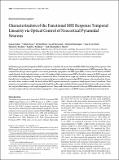Characterization of the Functional MRI Response Temporal Linearity via Optical Control of Neocortical Pyramidal Neurons
Author(s)
Kahn, Itamar; Desai, Mitul; Knoblich, Ulf; Bernstein, Jacob G.; Henninger, Michael Alan; Graybiel, Ann M.; Boyden, Edward Stuart; Buckner, Randy L.; Moore, Christopher I., 1968-; ... Show more Show less
DownloadKahn-2011-Characterization of.pdf (1.643Mb)
PUBLISHER_POLICY
Publisher Policy
Article is made available in accordance with the publisher's policy and may be subject to US copyright law. Please refer to the publisher's site for terms of use.
Terms of use
Metadata
Show full item recordAbstract
The blood oxygenation level-dependent (BOLD) signal serves as the basis for human functional MRI (fMRI). Knowledge of the properties of the BOLD signal, such as how linear its response is to sensory stimuli, is essential for the design and interpretation of fMRI experiments. Here, we combined the cell-type and site-specific causal control provided by optogenetics and fMRI (opto-fMRI) in mice to test the linearity of BOLD signals driven by locally induced excitatory activity. We employed high-resolution mouse fMRI at 9.4 tesla to measure the BOLD response, and extracellular electrophysiological recordings to measure the effects of stimulation on single unit, multiunit, and local field potential activity. Optically driven stimulation of layer V neocortical pyramidal neurons resulted in a positive local BOLD response at the stimulated site. Consistent with a linear transform model, this locally driven BOLD response summated in response to closely spaced trains of stimulation. These properties were equivalent to responses generated through the multisynaptic method of driving neocortical activity by tactile sensory stimulation, and paralleled changes in electrophysiological measures. These results illustrate the potential of the opto-fMRI method and reinforce the critical assumption of human functional neuroimaging that—to first approximation—the BOLD response tracks local neural activity levels.
Date issued
2011-10Department
Massachusetts Institute of Technology. Synthetic Neurobiology Group; Massachusetts Institute of Technology. Department of Biological Engineering; Massachusetts Institute of Technology. Department of Physics; Massachusetts Institute of Technology. Media Laboratory; McGovern Institute for Brain Research at MIT; Program in Media Arts and Sciences (Massachusetts Institute of Technology)Journal
Journal of Neuroscience
Publisher
Society for Neuroscience
Citation
Kahn, I. et al. “Characterization of the Functional MRI Response Temporal Linearity via Optical Control of Neocortical Pyramidal Neurons.” Journal of Neuroscience 31.42 (2011): 15086–15091.
Version: Final published version
ISSN
0270-6474
1529-2401